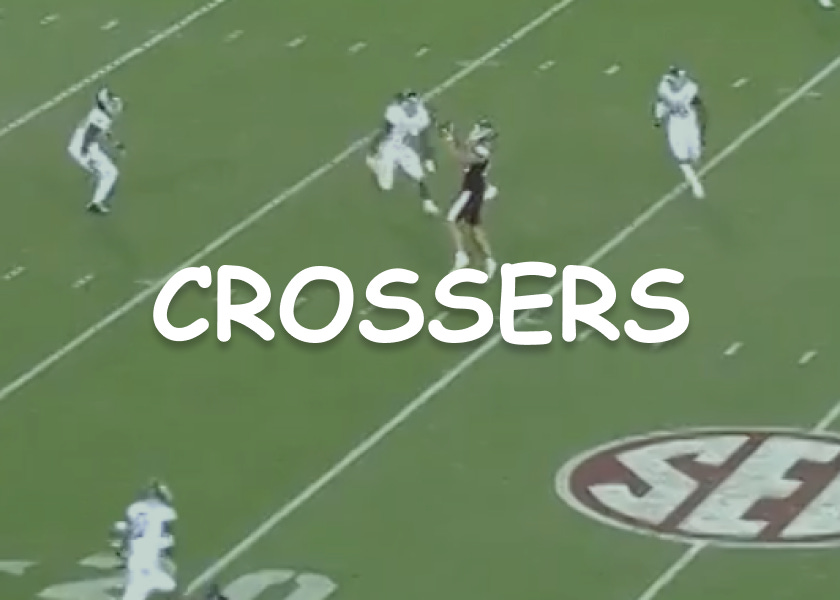I watched about 50 clips of four verticals out of 3x1 from the 2020 Mississippi State offense paying special attention to the number three receiver’s route: the crosser. That route has always been a struggle for us to hit consistently, and so I wanted to see how the late, great Mike Leach ran the route.
Out of these clips, I only found three completions so the dataset is limited, and I don’t assume to have gotten to the bottom of the matter. However, there were valuable insights.
I am going to pay special attention to the defensive structure, the release, the break, and the depth of the catch to see if there are commonalities.
Crosser Number One
Ole Miss is playing out of a drop eight, three high structure that is MOFC Zone and feels like Tampa 2. It’s three deep, five under.
The crosser takes a vertical release and then finds grass in between the underneath and deep coverage. The vertical release is effective because it’s the fastest path to the soft spot in the coverage, the middle. The crosser needs to get to other hash to create proper spacing between him and the seam route by the number two receiver, so he bends thataway after clearing the underneath defender.
The WR makes his break at 10 yards and makes the catch at 17 yards. It looks like this route is the first in the QB’s read and he throws it off a two-step and gather drop.
So this crosser is successful because there is so much space between the two layers of the defense.
Crosser Number Two
Once again, we’re seeing the crosser completed against a three deep, five under, drop eight coverage.
It’s truly remarkable, and shouldn’t be the case, that four verticals should be completed against drop eight. It doesn’t sit right, but alas, they’ve been able to do it twice.
The WR takes a vertical release but starts break this one off a little sooner at about six yards. He does this because he’s uncovered in the immediate vicinity. His real threat is the middle hook defender that ends up running with him. Though it’s not the traditional run with three up, and instead, the linebacker keeps his hips square to the line of scrimmage. This allows the WR to get past him horizontally. There is space over there because the curl defender gets sucked down by the running back releasing.
This crosser hits at a similar depth: 16 yards. Consistency in success. Both hitting at about the same depth, both against a drop eight.
Crosser Number Three
Drop eight. Again.
I’m not sure what the call would be for the Aggies, but the structure is the same as the past two. And again there is space for the crosser right past the underneath defenders.
This release is more similar to the first one — vertical and breaking right about 10 yards. His break is more flat though it takes a little longer for the ball to get out, and he makes the catch at 19 yards.
It still appears that the QB is looking to this route first, and this play is even more remarkable because of how long it takes. Against zone, the eyes of the defenders are on the QB. So for him to stare down this route and find success against drop eight is either remarkable or disturbing.
What Did We Learn
Though we are dealing with only three plays, hardly enough to draw definite conclusions, there were consistent themes of success. I’m not sure if it’s the experience of others too, but we don’t hit the route often. And after watching the 50 clips from Mississippi State, it appears they don’t either. I need to watch more to see what other looks it works against. Another important thing to look at would be when it didn’t work against drop eight.
But for the sake of today: the crosser is open when the route breaks right past the underneath defender, gets to a depth of about 16-19 yards on a flattish break, with no threat of a curl/flat defender.
Until tomorrow,
Emory Wilhite




